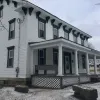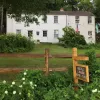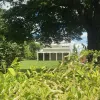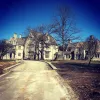Located in Meadville, the Baldwin-Reynolds House was once home to Supreme Court Justice Henry Baldwin (1780-1840) and, at other times, two of Meadville's mayors. Purchased by the Meadville Historical Society, the house now includes an ice house, tannery, garden, and spring-fed pond.
Historic Houses
Have you ever wondered where the first colonial settlement in northwest Pennsylvania was located? Well, look no further than Meadville.
Most of us are familiar with the story of Johnny Appleseed—the barefoot, bearded, coffee-sack-and-tin-pan-hat-wearing wanderer who traversed the American wilderness in the early 1800s, casting seeds and giving rise to umpteen apple trees across the Midwest.
On April 22, 1976, the Marshall House became the first building in Armstrong County to be added to the Pennsylvania Inventory of Historic Places. In May 1976, it was also placed on the National Register of Historic Places.
Birthplace and childhood home of ecologist and author Rachel Carson (1907-1964), whose 1962 book Silent Spring helped to launch the environmental movement. Guided tours and classes are available.
Go back over a hundred years and take a new look at a period in Pittsburgh’s history often characterized by the extremes of late 19th-century America: fabulous wealth and grinding poverty.
The Palace Theatre has been a significant force in Westmoreland County's cultural scene for generations.
In the late 19th century, the economic boom created by coal and Greensburg's growing importance as a retail and industrial center convinced the Pennsylvania Railroad to build the Train Station at Greensburg. The railroad commissioned architect William Cookman to design the new station.
The Greensburg Garden and Civic Center was built by philanthropist Katherine Mabis McKenna and donated to the City of Greensburg in 1969 as a memorial to her son, Mennel M. Smith.
The Elizabeth Township Historical Society owns and maintains the historic 220-year-old Greenock Log House on Greenock Buena Vista Road. Conservation of this landmark building provides a distinctive opportunity to learn about rural life in this place as early as 1790.
The Lawrence mansion is maintained as a house that evokes the elegant lifestyle of the Lawrences rather than a museum. It houses an excellent collection of original English and American antiques.
The museum which portrays the life and career of George Westinghouse, is focused on his career, accomplishments and inventions.
The Heinz Memorial Chapel began as a gift. Henry John Heinz, the founder of the Heinz Company established the building as a gift to his mother, Anna Margaretta Heinz. After Heinz’s death, his three surviving children added to his bequest to memorialize their grandmother and honor their father.










